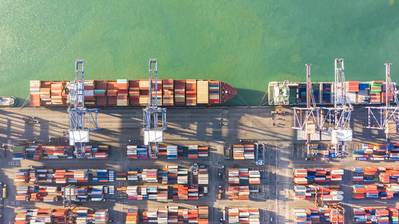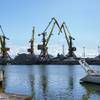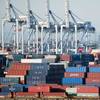World Trade Boom Keeps De-globalization at Bay
Globalization may have peaked, but the resilience of world trade in the face of mounting headwinds means a reversal of the past three decades is not inevitable.
Since the COVID-19 pandemic and Russia's invasion of Ukraine shattered global supply chains, debate has raged over how integrated the global economy will be in the future compared with the previous 30 to 40 years.
'Globalization' is an amorphous subject. According to the International Monetary Fund, economic globalization refers to "the increasing integration of economies around the world, particularly through the movement of goods, services, and capital across borders."
For many economists, globalization appears to have stalled after three decades of low inflation, easy credit, China's integration into the world economy and a relatively peaceful period.
The pandemic, rise of populist politics, war in Europe and China's military, economic and technological might have resulted in a world far more inclined to look inward rather than outward.
But even if its force is diminishing, reports of globalization's death may be greatly exaggerated.
Global trade last year reached, or got close to, record levels in nominal terms and, perhaps surprisingly with inflation at its highest in 40 years, in volume terms too.
As a share of global GDP, trade likely increased from the previous year's 57% and exports as per World Bank data. If so, it will be inching closer to the record 61% in 2008 which, by common consensus, marked 'peak globalization.'
Alessandro Nicita, an economist at the United Nation Conference for Trade and Development, says the structure of global trade will inevitably change - towards de-globalization or regionalization - but the process will be "selective" across industries and countries and could take five to 10 years.
"De-globalization is not here yet. It is not really evident in the data," Nicita says, estimating that global trade grew by about 3% last year, at a pace similar to the global economy.
From a long-term investment perspective the resilience of globalization forces should help cap inflationary pressures, to the benefit of emerging markets.
Regionalization
Global goods trade hit a record high last year, U.S. and European goods trade with China is also at all-time peaks, and global exports of digital services have more than tripled since 2005, according to Anabel Gonzalez, Deputy Director-General of the World Trade Organization.
"Trade and globalization are not on the wane, but they are changing," she told the Chatham House Global Trade Policy Forum in November, citing growth in service- and digital-based trade.
In dollar terms, trade flows across the three biggest economies are more powerful than ever.
China's exports and imports last year hit record highs of $3.59 trillion and $2.72 trillion, respectively, as did euro zone exports and imports - 2.88 trillion euros ($3.05 trillion) and 2.94 trillion euros, respectively - while U.S. exports to China and Chinese imports from the United States also hit record levels.
But the disruption in global supply chains since the pandemic and war in Ukraine has forced countries and regions to pursue greater self-sufficiency in energy, food, resources, technology and beyond.
The Biden administration has pushed through landmark fiscal packages - such as the Inflation Reduction Act and chips funding bill - that will involve unprecedented subsidies and funding for the green energy, technology and semiconductor industries.
China is working on a more than 1 trillion yuan ($144 billion) support package for its semiconductor industry, and Europe is sure to follow with similar projects of its own.
Economists at JP Morgan note the rising 'regionalization' of supply chains, with Asia now accounting for close to 79% of total machinery and transport equipment imports into China, up from 65% from 2017 to 2019.
Unipolar v multipolar
This 'regionalization' will continue assuming Beijing's economic, trade and financial ties to the U.S. gradually loosen. Deteriorating Sino-U.S. relations now come as thirty years of U.S. economic hegemony since the end of the Cold War appears to be ebbing.
A fragmented global economy with two U.S. and Chinese 'ecosystems' - or perhaps an even more multipolar world - will on aggregate probably be inflationary, keep interest rates structurally higher and deliver lower growth, economists argue.
Nearshoring and friendshoring is expensive, even more so at a time when prices and wages are already elevated.
Luke Templeman, analyst at Deutsche Bank, notes that economic expansions over the last 30 years have generally been longer than those in prior decades. One contributory factor is the fact that since the fall of the Soviet Union in 1991, the global economy has essentially operated in a unipolar framework.
It is a small sample size, and Templeman stresses that economic, financial, demographic and political factors were at play. But it is worth bearing in mind as the forces of de-globalization intensify over the coming years.
"The worrying thing is that as countries become more self-sufficient, there is less incentive to pursue a compromise with difficult trade partners," Templeman says.
($1 = 0.9428 euros. $1 = 6.9430 Chinese yuan renminbi)
(Reuters - By Jamie McGeever; Editing by Josie Kao. The opinions expressed here are those of the author, a columnist for Reuters.)















